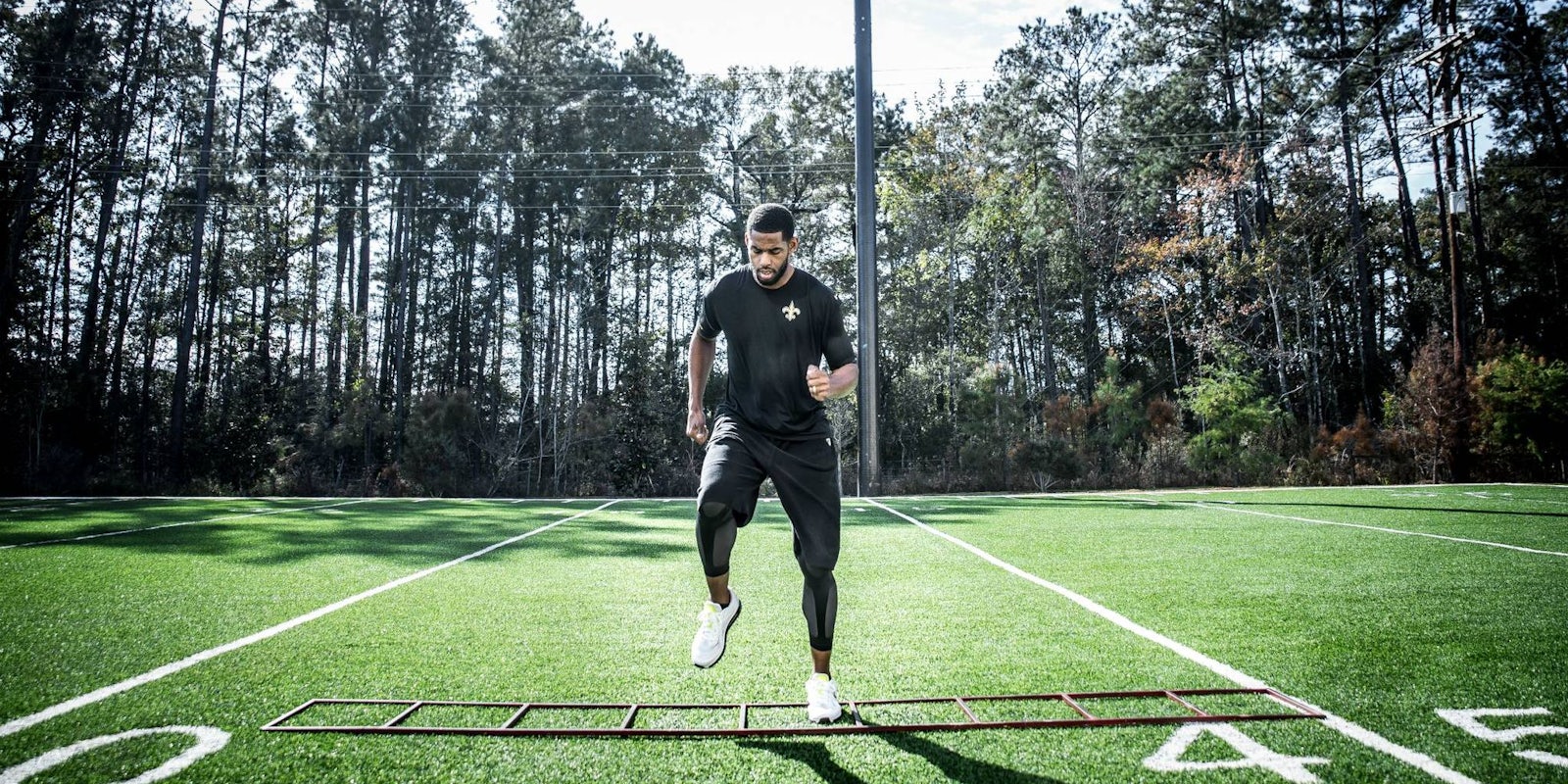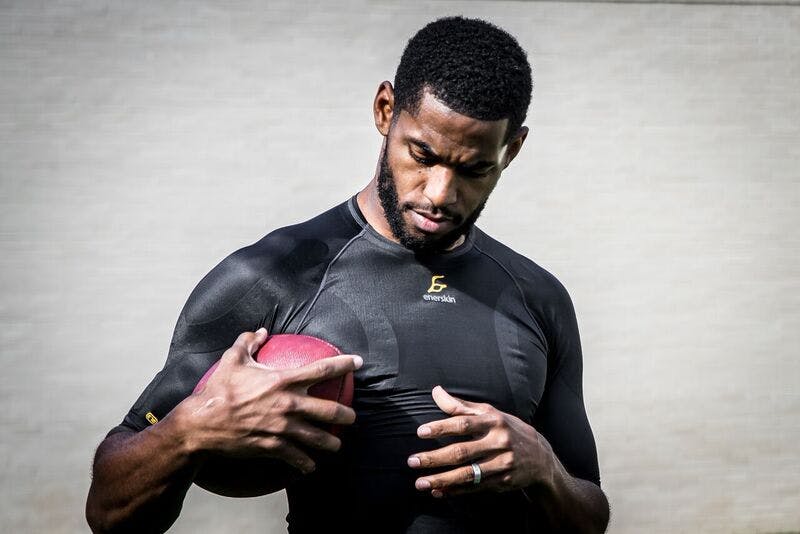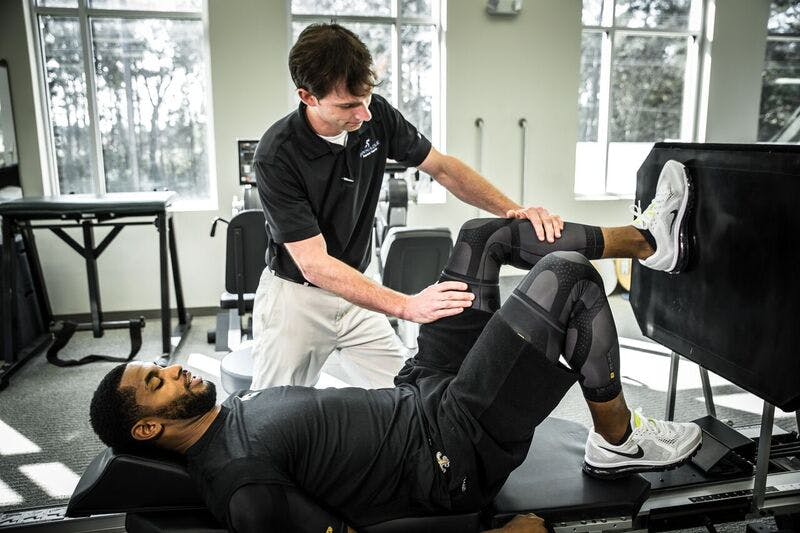There’s currently a dispute over how long the average career is for a player in the National Football League. The NFL Players Association argues the figure is just over three years. League officials reject that figure, stating it’s closer to six seasons. Pick sides, split the difference, process it however you want and the answer is essentially the same: a career in the NFL does not last long.
No matter which figure you decide to accept, Marques Colston is an outlier. Selected by the New Orleans Saints in the seventh and final round of the 2006 NFL Draft, Colston has been a contributor at wide receiver for a decade. He’s never switched teams, and has never missed more than five games in a season.
He has been the definition of consistency, but he got there because he made a change.
About five years ago, at a point where most NFL careers are approaching or have already reached an end, Colston decided to change his approach to training by embracing technology. He looked for new solutions to the old problems footballers have faced in some form since the inception of the sport, which includes everything from career-ending injuries to general wear and tear that can result in damage over time.
“It’s really more just about being proactive with your body and trying to create ways to prevent injuries as opposed to always trying to heal on the backend,” Colston tells the Daily Dot. “Just taking that approach has led me down this path to see what tools are out there to help me do that, and stay in front of some of these injuries and see if I can prevent.”
The most recent find for Colston is Enerskin, a company offering new takes on compression gear by utilizing the principles of therapeutic taping to squeeze out improved performance from the wearer.
“Some of the compression tights and the gear marketed as compression tights—there’s a difference between just having tight-fitting clothes and compression,” Colston said.
Enerskin uses medical-grade silicone to create the effect of therapeutic taping that is said to strengthen muscles, ligaments, and joints, as well as improve performance and reduce common sports injuries. Colston explained that it “assists the muscles that are going to be activated at any given point,” and said that it “creates a friction with the skin that mimics that kinesio tape philosophy.”
It sounds like a sort of miracle drug in wearable form, appearing too good to be true, and to some degree it might be. Both of the concepts utilized by Enerskin—compression clothing and therapeutic taping—have become popular in recent years. The popularity of compression has been attributed to its use in the National Basketball Association, particularly by Allen Iverson, while kinesio taping gained traction after wide use during the 2008 and 2012 Olympics.
There isn’t a real scientific consensus on the concepts; clinical studies from Enerskin show the product to be more effective than competitors, but most studies of compression and kinesio tape as separate entities have proven inconclusive.
If there is a type of athlete who would find a post in performance from either option, it would be a professional like Colston. A review of more than 30 studies on the effects of compression clothes in sports performance and recovery found that the gear works in specific instances. Areas where results were noticeable included short-duration sprints, vertical jump height, and extending time to exhaustion.
That essentially describes the job of a wide receiver to a T.
The compression gear showed to have additional benefits when it came to strength and power recovery and and reductions in muscle swelling and perceived muscle pain—a necessity for anyone who’s job description includes holding onto a ball while absorbing the impact of brutal, high speed collisions.
While the science might still be out when it comes to the benefits of compression and kinesio tape for the average athlete, Colston swears by the results he’s gotten from it.
“I think it made a really good impact, just being able to stay fresher throughout the week, using it in practice,” he said. “Playing football, you’re always going to get nicked up and have certain injuries that don’t necessarily keep you off the field. It helps to recover from those.”
He found the results good enough to put his money where his mouth is and announced an investment in the company in December. He’s not alone in his belief in the product, either; a handful of Colston’s teammates wore it throughout the 2015-2016 season, and his former teammate and current Philadelphia Eagles running back Darren Sproles is a user and investor in the company as well.
The embrace of the technology-centric Enerskin by Saints former and current isn’t much of a surprise given the franchise’s forward-thinking attitude in recent years. New Orleans was one of the first teams to adopt the shoulder pad-embedded RFID chips from Zebra Technologies. Colston said the team has been using the technology for three years now, primarily to monitor player workload.
“I think it’s helped them manage reps for certain guys who may be dealing with an injury or might be a little older, so I think from that standpoint, it’s been effective,” he said.
According to data recorded by Football Outsiders, the Saints suffered heavily from injury, recording 71.3 Adjusted Games Lost (AGL)—a metric that takes into account games missed by starters and reduced performance by players who are injured but still suit up. The next season, with a year of experience with the RFID chips under their belt, the team recorded 58.0 AGL, marking a significant improvement that moved the team into the top 10 for teams least impacted by injuries.
Football is generally considered to be a fairly primitive sport, and that’s an image it has a hard time shaking in part because of its violent nature and the embrace of unquantifiable concepts like “grit” and “willpower” being pushed in favor of actual, measurable information.
There’s still a distinct split between players who are more “old school” as Colston calls them, and players who are more willing to embrace technological solutions that might extend their career. That’s the primary reason Colston, by any definition a veteran player, has embraced .
“The way I came in the league put me on high alert that it can be over at any given time, so just finding ways to invest back into my body—this is my business right now,” Colston said. “It just made sense.”
That doesn’t mean Colston and other players don’t have reason to be skeptical. One of the primary issues surrounding the developing nature of sports technology is that there’s just so much new information and not a lot of time to decode it all.
For players, performance matters, but it has to be a discernible difference. Placebo effect improvements might make them feel better but won’t actually make muscles return to full strength faster.
“You feel like there’s a new product coming out every day,” Colston said, but expects that the tools that provide a true benefit will inevitably get adopted. In a league full of players looking for every advantage, it’s nearly impossible to keep it a secret when something is helping—even the hold outs who revel in the more brutal parts of the sport.
“I think guys getting in front of more equipment that they’re having really good experiences with will at least bring more guys to the middle of that conversation,” Colston explained. “I do see the trend growing as we move forward.”
The adaptation of technology isn’t just happening at a player level; organizations are, one by one, beginning to realize the benefits of a more scientific approach to the game.
“The last three or four years, there’s been a huge emphasis on analytics,” Colston said. “I think more and more teams are buying into the fact that having these numbers and having this technology play a part is making a positive impact.”
In Philadelphia, former head coach Chip Kelly went all in on data, equipping players with fitness trackers of just about every kind imaginable. Monitors from Catapult measured agility and acceleration, heart rate monitors were used to produce reports on post-workout recovery rates, and sleep monitors were used to make sure players got a good night’s rest before a game.
All of those data points can be used to create a much fuller picture of a player’s performance and what might be effecting it, assuming it’s applied properly. Kelly’s approach worked wonders for one year, but reports of players losing their patience with some of the more invasive trackers began to crop up, gaining more momentum as losses mounted.
Kelly eventually lost his job, not necessarily because of the increasing amount of technology that he was strapping on his players but for a failure to take that information and apply it in a way that resulted in wins. The Eagles missed the playoffs last year, and Kelly found himself without a position in Philadelphia, though he was quickly scooped up by the San Francisco 49ers.
He’ll take with him the same obsession with information with him, but it has already started spreading across the league regardless.
“I think it’s inevitable [for teams to adapt technology],” Colston said, but pointed out that it will only be useful if teams can figure out how to make the most of the information they’re collecting.
“One of the issues with a movement like this, that’s going more towards analytics is you need people who can analyze that data and can churn it out into useful information. I think just having somebody in-house that can do that and not get bogged down with other responsibilities, I think you’ll see that trend continue.”
Colston said he sees a staff position that acts as a “go-between with the athletic training staff and the strength and conditioning coaches, because that’s where the two intersect.”
With the wealth of information those staffers will have access to, players will want to know they have their best interests at heart. After years of controversy surrounding under- and unreported injuries that have led to life-altering damage and shortened lifespans for NFL players, there’s a considerable amount of distrust between players and doctors employed by teams.
According to a report from the Associated Press, many players believe the doctors treating them have more motivation to make decisions that benefit the team instead of the player. Fewer than half of the players surveyed said they think the teams, coaches, and doctors have the their best interests at heart when it comes to health and safety. That figure only gets lower the longer a player has been in the league.
Denver Broncos defensive end Antonio Smith, who has only missed one game in his 12 year career, told the AP that his health was because he decided to search out health solutions himself.
“You’ve got to get yourself a good system. Chiropractor, massage therapist, stretch therapist. A lot of guys are doing IVs now,” Smith said. “Take care of your body. You’ve got to do that. If the team doesn’t supply it, you spend the money.”
Until teams decide to take full advantage of technology and science available, players will have to continue to optimize their performance on their own. Colston expressed interest in exploring sleep tracking, and has embraced some monitoring gear for his own use. During the 2015-16 season, he began using equipment from company called Athos that gauges muscle activity in real-time and can be monitored through a corresponding mobile app.
“As athletes we’re always fighting against our bodies—sometimes your body isn’t necessarily made to do the things that you’re asked to do,” Colston said.
Injuries are almost entirely unavoidable in the NFL—Colston said the sport is “based on the principle” of pushing one’s body through pain—but new tools that track and monitor performance and gear like Enerskin can mitigate some of the injuries and long term effects caused by not fully recovering from them. “What information like this does is it makes that subjective decision making process more objective,” Colston said.
Colston attributed his longevity to his decision to incorporate data and technology into his training. As more of that information is folded into the day-to-day activities of athletes and organizations, players will hopefully be able to extend their time on the field without compromising their life off it.
Photo via Enerskin




